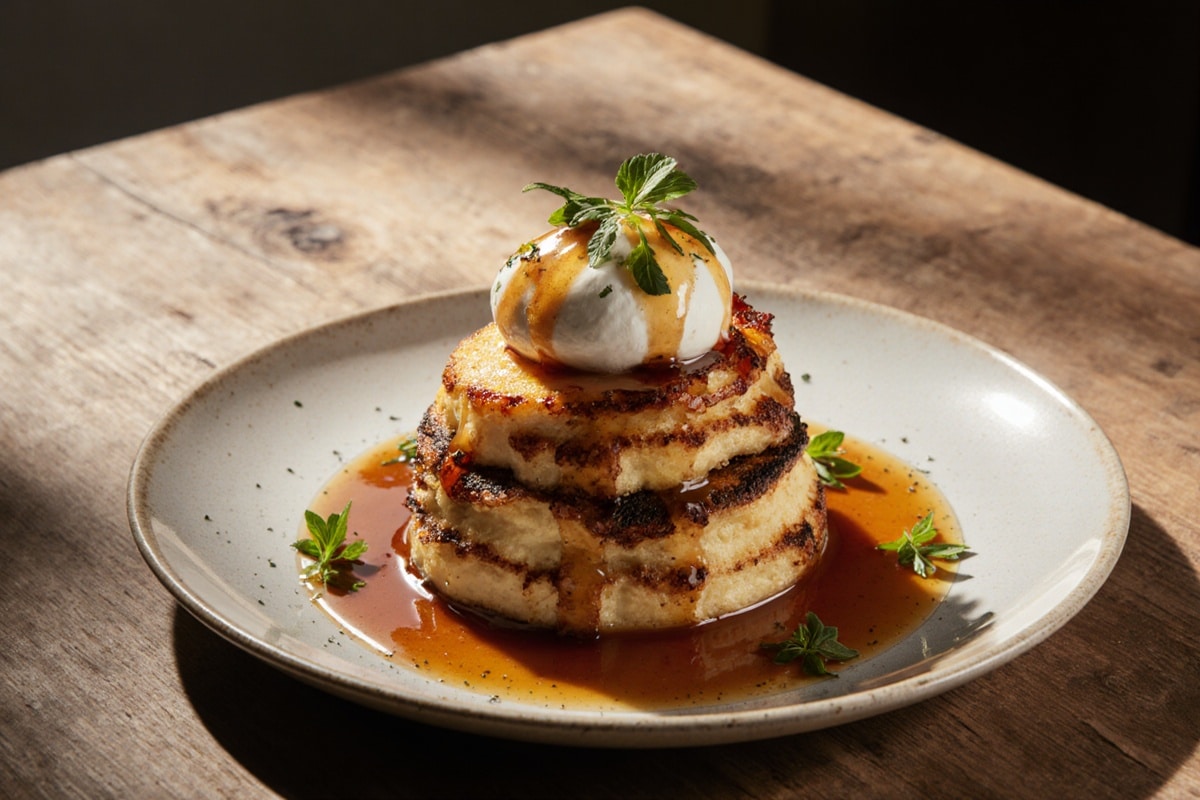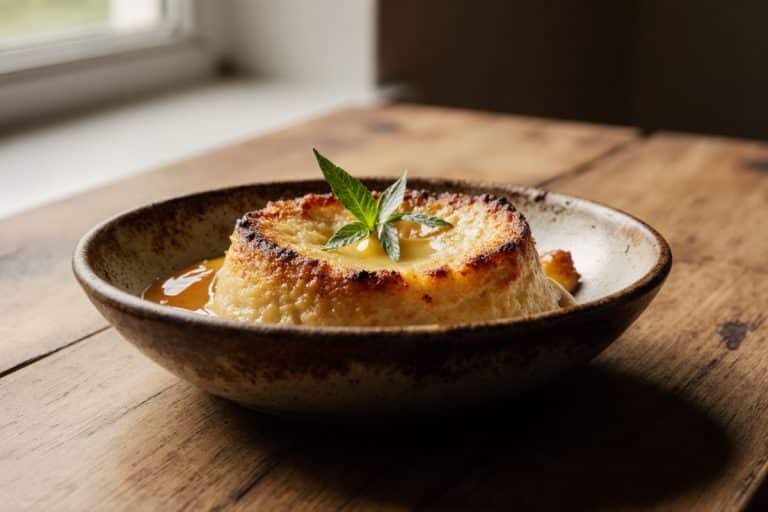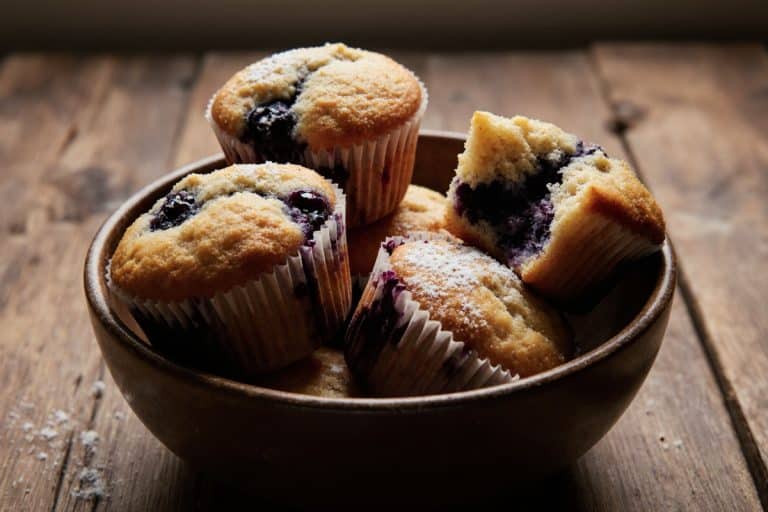Gordon Ramsay Baked Alaska Flambe
The gordon ramsay baked alaska flambe moment that changed everything happened in my kitchen—a disaster turned culinary triumph. I’d been massacring desserts for years, serving sad, melting ice cream disasters that would make professional chefs weep. But after studying Ramsay’s techniques, I discovered the art of transforming a simple dessert into a restaurant-quality spectacle. This isn’t just about making a sweet treat; it’s about mastering precision, controlling temperature, and creating pure culinary drama. With three key techniques—rock-solid freezing, perfect meringue, and a quick, controlled flambé—you’ll go from amateur baker to dessert maestro in one evening. No more soggy meringue, no more melted ice cream. Just pure, professional-level deliciousness that’ll make your dinner guests lean forward in anticipation.
Gordon Ramsay’s Legendary Baked Alaska Flambé
Ingredients
Equipment
Method
- Freeze your ice cream core for at least 8 hours, preferably overnight. Use a metal mold lined with plastic wrap for easy removal.
- Heat sugar syrup to 115°C while beating egg whites to soft peaks. Slowly stream hot syrup into the whites, continuing to beat until glossy peaks form.
- Layer the frozen cake base, followed by the ice cream core and the prepared meringue, sealing all edges completely.
- Bake in a preheated oven at 220°C for 8-10 minutes, just enough to brown the meringue without melting the ice cream.
- Warm the liquor, carefully ignite, and pour over the meringue to flambé, limiting the flame time to 20-30 seconds. Serve immediately on a pre-warmed plate.
Nutrition
Notes
Love this recipe?
Give us 5 stars and comment!Gordon Ramsay’s Legendary Baked Alaska Flambé: A Culinary Spectacle
What Makes Ramsay’s Baked Alaska Special
When I think of Gordon Ramsay’s Baked Alaska, I see more than just a dessert; it’s truly a performance in the kitchen.
His precision and theatrical presentation set this dish apart.
Ramsay takes a timeless dessert and turns it into a stunning showpiece, using techniques that make every element shine.
He requires perfect execution: rock-solid ice cream, glossy Italian meringue, and that exciting flambé that gets everyone leaning in close.
Essential Key Ingredients for Success
The magic begins with top-notch ingredients. You’ll need high-quality vanilla ice cream, a sturdy cake base like sponge or genoise, and flawless egg whites for the Italian meringue.
Pro tip: Use fresh, room-temperature eggs to achieve maximum meringue volume.
For the flambé, choose a good brandy or cognac—avoid anything cheap.
Each ingredient plays a vital role, creating the right temperature contrast and flavor balance that makes Ramsay’s style so special.
The Dramatic Flambé Element
Flambéing is more than just catching alcohol on fire—it brings flavor and excitement to the table.
Limit your flambé to 20-30 seconds to keep the delicate meringue from melting.
The alcohol burns away quickly, leaving a delicious caramelized note and a little hint of complexity.
This technique takes a simple dessert and transforms it into a dining experience that feels top-tier.
Nutritional Breakdown of This Decadent Dessert
Calories and Macronutrient Profile
A standard serving of Baked Alaska comes in around 600-750 calories.
The breakdown of nutrients shows a rich profile: about 20-24g of fat (with around 14g being saturated), 5-8g of protein, and 30-60g of carbohydrates.
This isn’t a dessert for a diet—it’s meant to be a special treat.
The fat comes primarily from the ice cream and egg-based meringue, making this a truly indulgent delight.
Micronutrient Considerations
Even with all its richness, the dessert has some nutritional upsides.
You can expect roughly 15-20% of your daily calcium needs and 10-15% of iron in each serving.
The egg whites provide quality protein, while the dairy brings in essential minerals.
Remember, moderation is key—enjoy this as an occasional celebration rather than a regular indulgence.
Health-Conscious Approach
Though absolutely delicious, Baked Alaska is high in saturated fat and sugar.
The flambé technique burns off some alcohol, adding depth without a significant calorie boost.
If you’re looking for a lighter option, think about using low-fat ice cream or reducing your portion size.
Pro health hack: Pair it with fresh berries for extra nutritional balance.
Step-by-Step Baked Alaska Method
Preparing the Ice Cream Core
Freezing is crucial for this dessert.
Make sure to freeze your ice cream core for at least 8 hours, preferably overnight.
Using a metal mold or cake pan lined with plastic wrap will help when it’s time to remove it.
Your goal is a super solid ice cream base that won’t melt when it hits the oven.
Blast freezing after the first freeze can boost stability even more.
Crafting the Perfect Italian Meringue
Getting Italian meringue right is what sets a professional apart from a novice.
Heat sugar syrup to 240°F while simultaneously beating your egg whites to soft peaks.
Slowly stream the hot syrup into the whites while continuing to beat, creating a shiny, stable meringue that can handle high oven temperatures.
A pinch of cream of tartar can also help keep things stable.
Assembly and Baking Technique
Layer your frozen cake base, ice cream core, and expertly prepared meringue.
Make sure to cover the entire dessert completely, sealing all edges.
Bake at 425°F for 8-10 minutes—just long enough to give the meringue a nice brown color without melting your precious ice cream.
Keep a close eye; this is where precision is key.
Flambé Execution and Serving
To bring the drama tableside, you need to be confident.
Warm your chosen liquor (brandy or cognac work best), ignite it carefully, and pour it over the meringue.
Limit the flame to 20-30 seconds to avoid melting.
Serve right away on a pre-warmed plate to maintain that wonderful temperature contrast.
Ramsay’s Pro Tips and Common Mistakes
Meringue Stability Secrets
Under-beaten meringue collapses faster than a soufflé in a breeze.
Beat to stiff, glossy peaks using the Italian method.
To test stability, invert your mixing bowl—if it holds its shape, you’re on the right track.
Cream of tartar helps add structural integrity.
Freezing and Baking Precision
Freezing isn’t optional—it’s essential.
If you can, blast freeze your assembled dessert before baking.
Bake at exactly 425°F for no more than 10 minutes.
Lower temperatures lead to soggy meringue, while longer baking times cause melted ice cream.
Flambé Safety and Execution
Have a fire extinguisher at the ready.
Use long matches or a culinary torch for safety.
Never pour alcohol directly from the bottle near an open flame.
Practice your flambé technique before showing it off tableside.
Creative Variations and Alternatives
Ice Cream Flavor Explorations
Vanilla is classic, but why stop there?
Try chocolate, raspberry ripple, or even salted caramel.
Choose your ice cream based on the season or your cravings.
Cake Layer Innovations
Swap the traditional sponge cake for gingerbread during the holidays, or go for a rich chocolate base for an intense flavor contrast.
Each cake choice brings a new twist to your Baked Alaska.
Meringue and Liquor Variations
While Italian meringue is the go-to, Swiss meringue offers a simpler option.
Feel free to experiment with rum, Grand Marnier, or whiskey for a variety of flavor experiences.
Perfect Pairing Recommendations
Berry Accompaniments
Fresh berries or a quick berry coulis can brighten the dish and balance out its richness.
Citrus Palate Cleanser
A light citrus salad featuring orange segments and mint can refresh your palate after enjoying this rich dessert.
Wine Pairing Wisdom
A crisp sparkling wine or champagne perfectly complements the sweet, rich flavors, helping to cleanse your palate with each bite.
Ready to give it a go? For more on this classic dessert, check out Baked Alaska!
Video tutorial: baked alaska
FAQ – gordon ramsay baked alaska flambe
Question: Can I make Baked Alaska ahead of time?
Answer: Absolutely! Assemble and freeze completely, then bake just before serving. The prep-ahead strategy is a pro move that saves last-minute stress.
Question: What’s the biggest mistake home cooks make?
Answer: Not freezing the ice cream core solid enough. Blast freeze that bad boy overnight for guaranteed success.
Question: Which liquor works best for flambé?
Answer: Brandy or cognac are classic choices. They add depth without overpowering the dessert’s delicate balance.
Question: How do I avoid a melted mess?
Answer: Precision is key. High heat, short baking time, and a rock-solid frozen core prevent ice cream disaster.
Question: Can I use different ice cream flavors?
Answer: Go wild! Chocolate, raspberry, salted caramel—match the flavor to your mood or the season.
Conclusion
When you nail this Baked Alaska, you’ll feel like a culinary rockstar. Imagine the moment—golden meringue, perfectly caramelized, flames dancing around your dessert as guests watch in awe. This isn’t just cooking; it’s performance art. The temperature contrast, the boozy hint of flambé, the crisp meringue exterior giving way to cold, creamy ice cream—it’s pure magic. Every technical detail matters, from egg white peaks to flame duration. But more than technique, this is about confidence. About transforming a potentially disastrous dessert into a showstopping masterpiece. Now it’s your turn. Fire up that kitchen, channel your inner Ramsay, and create something extraordinary.









